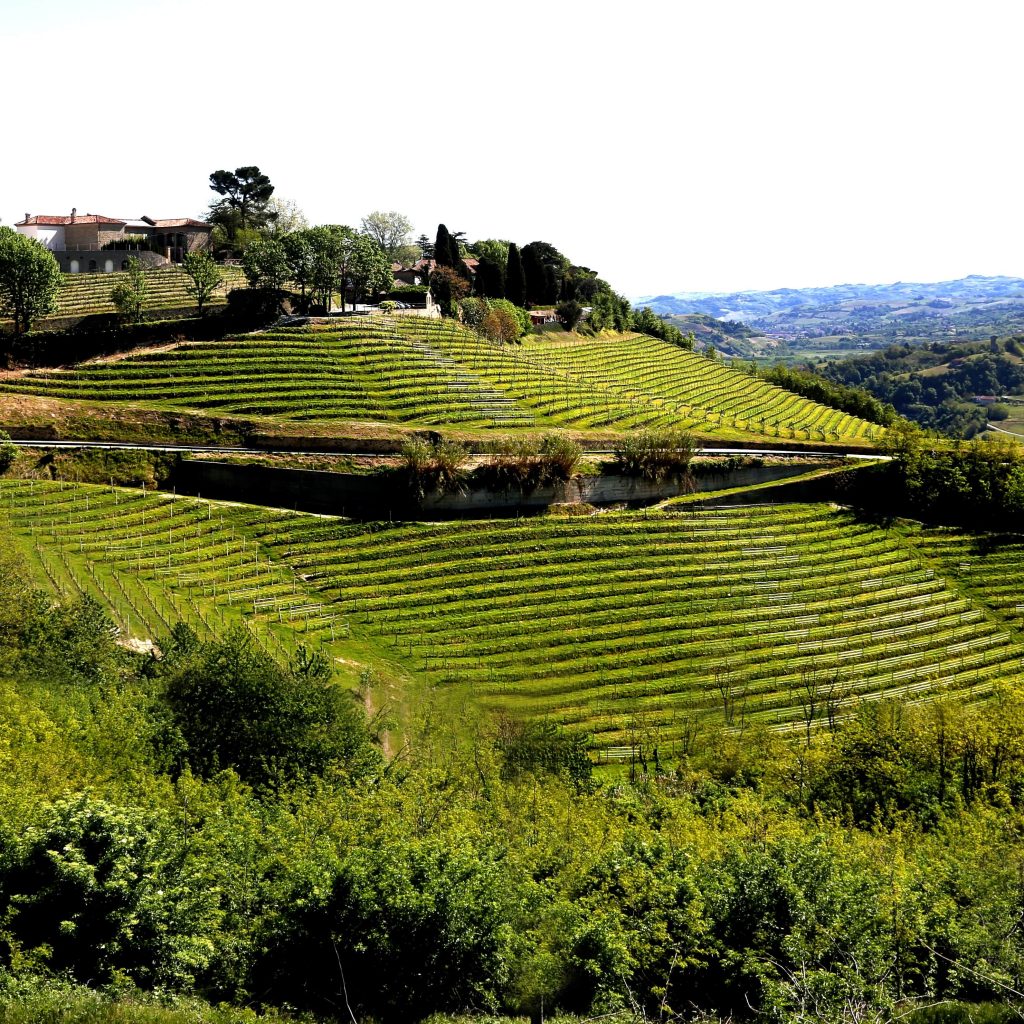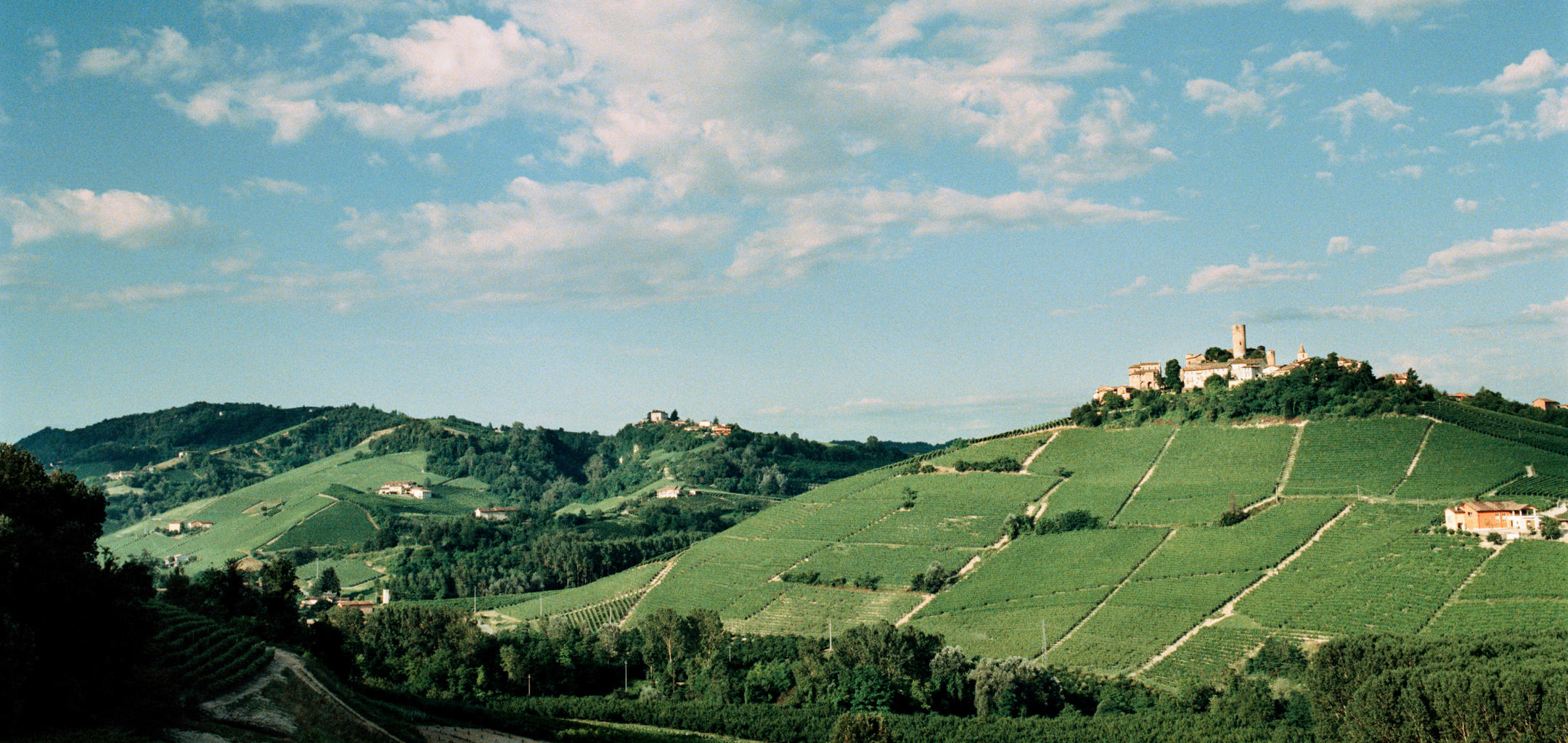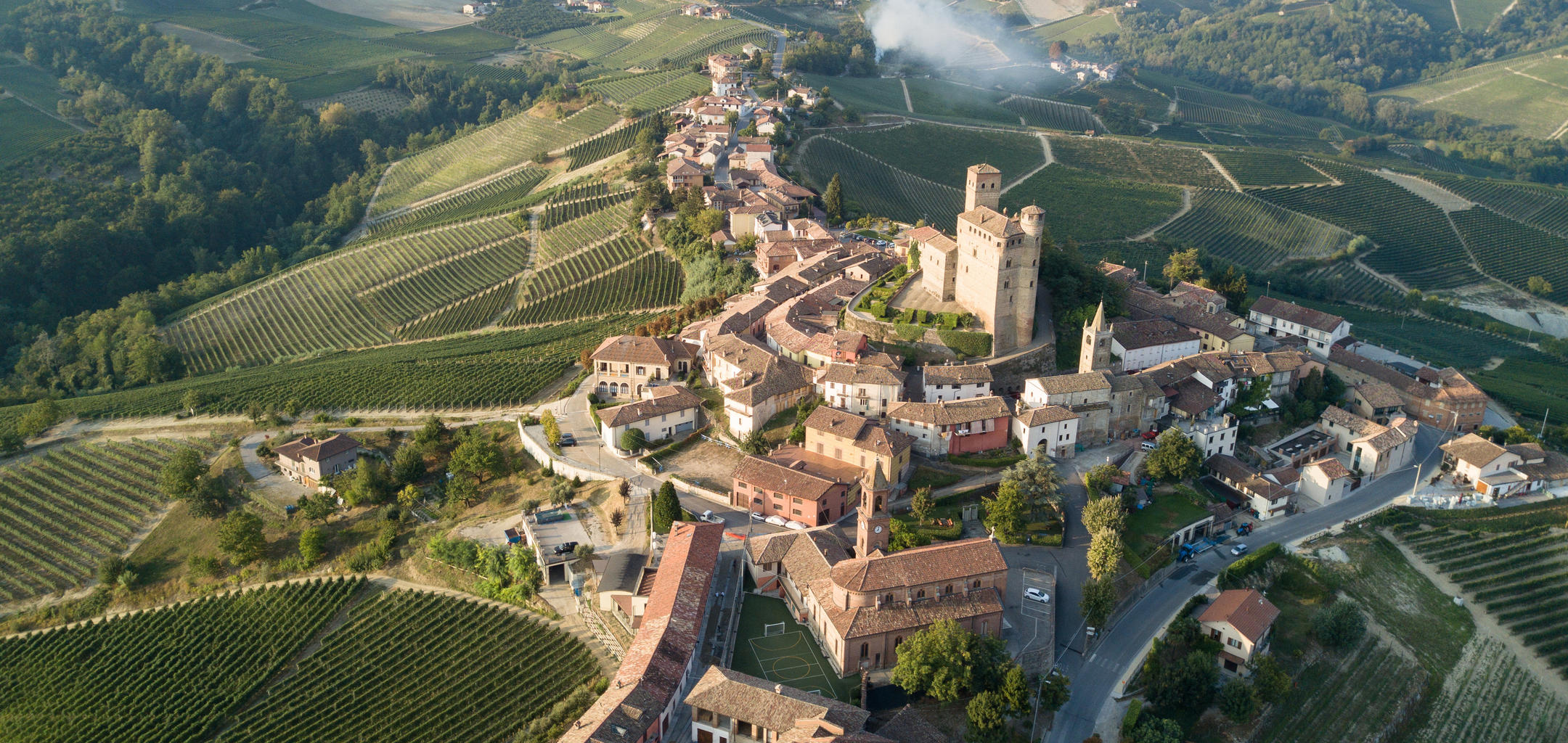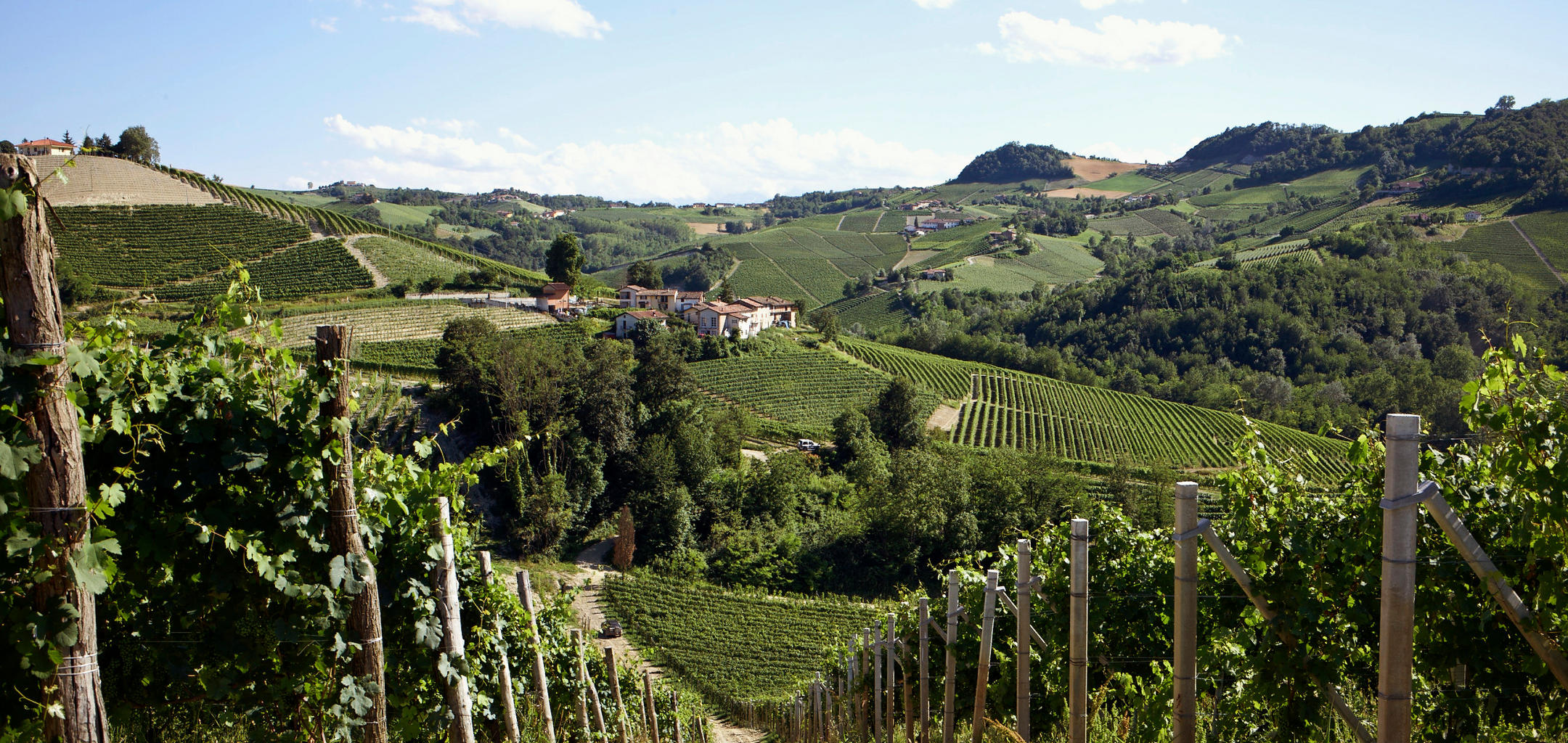A guide to the Barolo villages
Author: Davy Żyw

The Barolo region is a patchwork of diverse villages and terroirs, each offering its own distinct character. Italy Buyer Davy Żyw outlines the key Barolo villages to look out for.
The 2018 vintage gives us a soft rose-tinted lens, through which one can explore the details of this ancient landscape. This vintage is not one of extremes, but we find that each village – and even producers within the same village – had different experiences of the growing year.
This underscores how complex this terroir is, and Nebbiolo’s talent to express its fine details. The ’18 release gives us a transparent view into the character of the village, the role of vineyards within multi-vineyard and village blends, and an insight into the monolithic expressions of single crus. This year, in particular, has seen clear-cut distinctions between site and villages styles.
The Langhe is home to some of the oldest soils on the planet, pushed to the surface as the African and Euroasian tectonic plates collided together, creating the Alps. Over millennia, the Piedmontese Ligurian Tertiary Basin began to sink back towards the sea, pushing even older soils to the earth’s surface.
The oldest soils in the region are located in the east of the region, dating back to the Helvetian period. Here, we find the ancient white soil and marls of Serralunga, Monforte and Castiglione Falletto. We also find some of the region’s youngest soils – some 5 million years old – in the west, in La Morra and Verduno. These date back to the Tortonian age; they are rich with sand and clay, with mineral blue marl. A general rule when observing the wines of Barolo is that the older soils give more finesse, with finer, but firmer, tannins and minerality; whilst the younger dark soils give greater fruit volume and thicker tannin structure.
But there are many exceptions. Different stratas which have been exposed over time – such as Diano sandstone and limestone-rich Sant’Agata marl – play an important role all over the region. This is a common factor in many of the best vineyards. Altitude, too, plays an important role – principally, for climatic reasons, but it also provides a vital key to understanding the region’s complex geology. Hillsides exfoliate over time, exposing a variety of soils at different elevations.
Generally, there is a connecting thread in each of the villages, linking styles and character based on soil type, altitudes, exposures and microclimates. We are lucky to work with a strong pedigree of producers who make wines so illustrative of their village personality – and of Barolo as a whole.
LA MORRA
La Morra is the largest of all the Barolo vineyard areas, and the furthest west. As with our three La Morra-based Barolisti, producer philosophies vary here, as does the range of aspects and altitudes. The top vineyards are grown on calcareous Sant’Agata marl, the best of which are on the eastern flank of La Morra’s ridge. There are many naturally south and south-east-facing amphitheatres carved into the hillside below the town’s terracotta clocktower, above Marcarini’s cantina. Grand Cru-worthy Rocche dell’Annunziata is a jewel in the village’s crown, known for the elegance, depth and quality of tannin it gives. But nearby Brunate, which means “roasted” in the local dialect, gives wines of broader structure, earthy complexity and power.
The most famous vineyards here rival the greatest sites in the whole region, but there are other sites which showcase La Morra’s wider appeal and personality clearly. Alessandro Veglio’s careful hand articulates the subtle differences of his Arborina and Gattera sites, both showcasing such individual expressions of village and vineyard but woven with the fleshy La Morra charm. The thread of the villages’ vineyards is that many are planted on younger, heavier Sant’ Agata marl which is laced by silt and calcareous layers. This gives gloss, elegance and richer fruit weight to the wines, compared to other villages.
As demonstrated by Marcarini’s Comune di La Morra Barolo, the village wines here are less tense and more pleasing in youth than other villages. Minerality plays a supporting role rather than the headline; aside from the cellar-worthy top crus, the wines offer fuller, juicier fruit with spicy aromatics. This is a village which offers the perfect introduction to new Barolo enthusiasts, but equally has something to offer to the most passionate collectors of the region’s best wines.

CASTIGLIONE FALLETTO
The most central of the villages, the hilltop Castiglione Falletto forms a naturally fortified island above two rivers on either side. These rivers have sculpted some of the steepest vineyards in the area, revealing an incredible diversity of soils – spanning the white calcareous soils of Serralunga d’Alba; the mineral-flecked Sant’Agata marl found in Barolo and La Morra; and the lighter, alluvial sand, which lends elegance and aromatics to the wines.
Although Mario Fontana’s winery is in technically in Monforte d’Alba, his heart and soul is in Castiglione Falletto. In 2018, he chose to blend his top Villero and Valleti cru into his Barolo Classico, showcasing the village’s finesse.
This year, we include two of the most desired sites in the village, courtesy of Federico Cerretto, including his inaugural release of Rocche di Castiglione. But his crown vineyard – the highest in the village – is Bricco Rocche. This cooler site is one of the village’s greatest expressions, illustrative of the class of Castiglione Falletto’s terroir.
The wines of the village are filled with an unmistakable floral perfume. They combine elegance, vivid minerality and sweeter tannins, more than any other village – but are by no means less serious.

SERRALUNGA D’ALBA
Serralunga d’Alba is the furthest east of the Barolo communes. The village’s ridge runs due south to north, with vineyards descending both to the east and west off this calcareous, steep-sided spine. The wines of Serralunga have a signature austerity; they are vertical, complex and compact. Altitude plays a role, too, but it is the exposures and geology which give Serralunga its character.
The soils here are the oldest in the region. They are poor, white talc – unfertile and calcareous. This manifests in wines as tension and saline minerality, which are often wrapped in austere tannins that can be demanding in youth. Some producers were affected by hail and climatic pressures in 2018. Franco Massolino opted not to produce his crus, instead blending into his Barolo Classico. And so, we are treated to a rare combination of some of the village’s finest sites, with enthralling results.
Historically, the best sites are the south-facing hanging valleys to the east of the village, and the ’18 Vigna Rionda is one of the vintage’s great triumphs. But increasingly, the ancient soils of the east- and west-facing sites have resulted in outstanding ’18s; these include Davide Rosso’s Cerretta and Serra, Cerretto’s Prapo and Bruna Grimaldi’s Badarina. Rosso’s wines are particularly illustrative of this village; he describes the wines of his hometown as mineral, powerful and full of class.

BAROLO
Barolo is the beating heart of the entire area, the name “Barolo” referring to both the wider region and its principal wine village. The terroir here is complex, combining the best traits from across the region. Barolo’s historical fame continues to grow, thanks to its now-iconic winemakers – particularly Bartolo Mascarello, Barale-Rinaldi and, more recently, our friend Luciano Sandrone. The village has some of the greatest vineyards, sandwiched between the hilltop ridges of Castiglione Falletto and La Morra.
None are greater than the hilly saddle of vineyards which sits below the town, flanking the south-east side of the only road. These vineyards are named Cannubi and Cannubi Boschis. This site is almost directly in the centre of the whole Barolo region, where the river divides the ancient hills of Barolo and La Morra from those of Castiglione Falletto and Serralunga d’Alba.
This is the only site in the entire region where Tortonian and Helvetian soils from different geological eras meet. This compression of tectonic power gives a unique complexity to the soils, giving the wines energy and expressive intensity. They are perfumed, often enveloped in fine, yet demanding tannins. This is perfectly showcased by Sandrone’s Aleste, arguably the greatest expression of Cannubi Boschis – Luciano, like his predecessors, knew this was a prized site.
There is ample diversity within the village boundaries. Veglio’s Paiagalo sits above the town with views over the castle. This south-east facing vineyard gives elegant, rich fruit to the palate, with more presence and fine, firm structure – a classical trait of the Barolo village style. If we follow the winding counters and tracks above the town, we come to Guiseppe Vajra’s Bricco di Viole – one of the regions’ highest (and coldest) vineyards, with views overlooking the Alps. Along with Francia in Serralunga, this is one of the last vineyards to be harvested, giving energy and a floral perfume to the wines.
Overall, the styles in Barolo combine many of the classical traits we associate with the best wines of the region: perfumed, floral nose, earthiness, tangy fruit, china-fine tannin and elegance, and minerality – yet without the tough austerity of many neighbouring sites.
VERDUNO
Verduno is located in the far north of the region, on the very edge of the Barolo zone. What sets the wines apart is their finesse and elegance; the colours are paler, the wines fresher and lighter.
Verduno’s finesse can be attributed to its exposure to cooling alpine winds, as well as its mixed soils: calcareous gypsum, limestone-filled Sant’Agata marl, and sandstone all play a key role. Fratelli Alessandria’s wines – including Vittore’s ’18 Comune di Verduno Barolo – are so emblematic of the village’s personality. Although more voluminous than some vintages, they carry the fine, graceful elegance for which Verduno is known.
For this release, we’re pleased to introduce Cascina Massara Burlotto, giving us a new viewpoint to study and enjoy this special village. Make sure to look out for their Massara cru, which rivals the legendary Monvigliero in ’18.

MONFORTE D’ALBA
Monforte d’Alba is the southernmost Barolo commune and the most misunderstood. It offers a multitude of soils, aspects and elevation, reaching heights of almost 500 metres. There are many outstanding sites in Monforte, but the commune has only classified 10 MGAs (menzione geografiche aggiuntive, often referred to by the French word cru). This is in spite of the fact that the area is larger than other village vineyards; therefore, a deeper knowledge of the MGAs is needed to find the most prized wines.
Among the greatest sites, we have Alessandria’s Gramolere and Veglio’s Castelletto, showcasing the dual identities of the village. To the west, younger more fertile sandstone and heavier soils yield wines with breadth of fruit, palate weight, spice and intensity.
To the east of the village, the soils are different; the slopes are a continuation of the calcareous Serralunga d’Alba ridge line. This impacts much of the mineral austerity found in Serralunga; the wines are firmer, more delicate in fruit and with sapid minerality.
Fratelli Barale’s Barolo ’18 – which comes from the San Giovanni vineyard – is demonstrative of this two-fold Monforte personality, with gleaming sandstone tannins and long-lasting mineral purity. We’re pleased to offer it for the first time this year.
Browse our complete Barolo 2018 En Primeur offer here.


